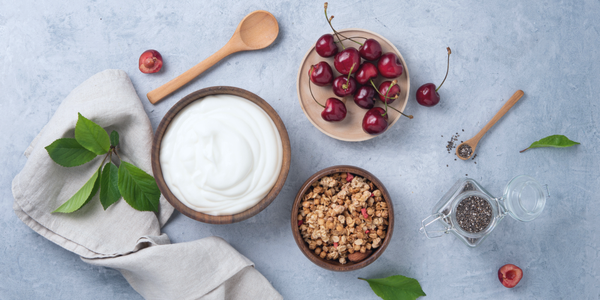
Here’s an exciting, exciting truth: you can eat dessert and still achieve your weight loss goals! While finding desserts for weight loss can feel tricky, especially over the holiday season, plenty of options are equally nutritious and delicious.
Sweet tooth throbbing? Satisfy your cravings with these healthy desserts for weight during the holidays (or any time of year) with these ideas.
Besides, “How often should you eat dessert?” is relative, and you might be surprised to learn you can enjoy it more frequently than once thought!
Can You Eat Dessert for Weight Loss?
It can be tempting to completely cut out desserts while trying to lose weight. However, getting rid of desserts altogether may make them more irresistible.
Diet experts suggest a different approach: Instead of deprivation, try moderation and mindful eating when approaching the dessert table.
Avoid All-Or-Nothing Thinking
An all-or-nothing approach to health can force you to put food into two categories— “good” and “bad.” As you may have predicted, with this thinking pattern, many desserts fall into the “bad” category. Especially during the holidays, this method of categorizing food can take the joy out of the most wonderful time of the year.
Instead, it may be more productive to place desserts on a sort of sliding scale, so they are allowed to have ingredients like sugar while also offering healthy benefits (from ingredients like fruit). Viewing desserts in a more positive light, instead of completely depriving yourself of all things sweet, can help you enjoy treats without going overboard.
Tap Into Intuitive Eating
The idea of intentionally indulging is popular among many mindful eating experts, such as one of the authors of Intuitive Eating, dietitians Elyse Resch and Evelyn Tribole. Of holiday eating, Resch says, “Even kids exposed to gobs of Halloween candy do not want to indulge for long. And when you know you can truly have the food again…it doesn’t take much to satisfy you.”
Basically, instead of overindulging, the approach of intuitive eating encourages you to listen to your body’s hunger and fullness cues. It permits you to eat when you are hungry but also stop when you are full. Although studies suggest intuitive eating has had mixed results in weight loss, it can contribute to positive changes in quality of life and body image, which can ultimately remove barriers to healthy eating and contribute to weight loss efforts.
It may feel supportive for you to explore another resource authored by Resch and Tribole, an Intuitive Eater’s Holiday Bill of Rights. This outline for holiday eating suggests honoring your fullness, even when relatives may be pushing dessert on you. It also reminds you that it’s okay to enjoy a slice of pumpkin pie!
Ask A Crucial Question
One important question to ask yourself when you have a dessert craving is, “is this craving emotional or physical?” Around the holiday season, stressors can be prevalent. Instead of mindlessly eating in response to every craving, intercept those thoughts by asking yourself where the craving is coming from.
If you’re truly hungry and craving desserts, there are plenty of healthy dessert options to choose from. In other words, you can satiate your body without sacrificing on dessert flavors you know and love!
How Often Should You Eat Dessert?
Wouldn’t it be nice if there was a universal dessert recommendation that told you exactly how much of your favorite foods you were allowed to eat? Unfortunately, that’s not the case, but health experts do have a few guidelines when it comes to dessert.
In general, the amount of dessert you can allow yourself to eat depends on the type of dessert you’re eating and how much. For example, if you’re eating a smaller portion of a dessert that’s more nutrient dense, you may be able to eat dessert every day. On the other hand, if you want to eat a larger slice or scoop of something that’s relatively low in vitamins and minerals and high in added sugars, it may be best to limit your dessert intake to once or twice a week.
When aiming for weight loss, many people find the “90/10” approach to be helpful for improving their health. Essentially, this approach encourages you to make healthy food choices 90% of the time, and leaves the other 10% as wiggle room (where foods like dessert can fit in). Many people find that this approach allows them to balance both mental and physical wellness in a healthy way.
Regardless of your method, most studies suggest it’s healthiest to eat fewer desserts than you are of other foods, since desserts can be excessively high in fat and calories. Typically, it’s recommended to enjoy a sweet treat every now and then, but not make it a part of your daily routine (unless the treat is truly health-promoting).
Healthy Desserts for Weight Loss: Tips and Ideas
Dessert can definitely be enjoyed as part of a well-balanced eating pattern. Finding healthy desserts is a crucial part of healthy eating, especially if you’re prone to cravings for sweets. The following tips can help you to healthily incorporate dessert into your diet while still supporting weight loss and health goals.
Attune Your Taste Buds
One of the oldest diet tricks in the book for when you’re craving something sweet is to first try drinking a glass of water, then try having a ¼ cup nuts or a ½ cup fruit to see if your hunger subsides. It’s alright to go straight to dessert if you’re certain that’s what you want, but there may be some wisdom in this old adage.
Some foods, like fresh fruit, can start to taste sweet as you gradually reduce added sugars in your diet and replace them with naturally sweet foods. Fruits can add a pleasant aroma, color, and variety to dessert that may not otherwise be there.
During the fall and winter holidays, it can be fruitful to look for desserts high in seasonal fruits and veggies, such as:
• Apples and pears
• Cranberries
• Citrus (such as oranges and grapefruit)
• Figs
• Pomegranate
• Pumpkin
• Sweet potatoes
Luckily, many holiday desserts are also naturally nutty! Walnuts and pecans are popular picks, and nuts like almonds, hazelnuts, and cashews can have a naturally sweet flavor. However, it’s always a good idea to practice moderation, since nuts can be high in calories, too.
Measure Against Other Meals
When choosing desserts, you may find it helpful to ask, “What have I already eaten today?” If you’ve eaten foods high in saturated fat, sugar, or calories throughout the day, choosing a more nutrient-rich dessert may be better. The amount of dessert you “should” eat can also depend on other factors, such as your metabolism or your activity.
Another useful tip for measuring how healthy your dessert choice is to see if it could double as a healthy breakfast or snack. If the answer is no, it may be worth looking at your item.
For example, overnight oats can take on the flavor of apple pie (thanks to the sweetness of apples, cinnamon, and nutmeg) but at a fraction of the calories. Plus, they can be enjoyed as a breakfast, snack, or dessert!
Reduce Sugar In Homemade Recipes
Making your own desserts home can be a healthier way to recreate your favorite dessert recipes. Start with subtle swaps, like dark chocolate chips instead of milk chocolate ones. Then, try other healthy food swaps until you achieve the perfect balance of nutritious and delicious!
In most recipes, sugar can be reduced by ¼-⅓ without affecting the taste too much. If the recipe calls for 1 cup of sugar, you could try using ⅔ cup or ¾ cup instead. With some trial and error, this method can turn traditional recipes into treats with a healthy twist.
Another trick for creating homemade recipes is to capitalize on taste and texture. Generally, desserts are characterized as sweet and creamy. Certain flavors can enhance sweetness without adding the calories of sugar. These flavors include:
•Cinnamon
•Nutmeg
•Vanilla
Similarly, certain foods can add creaminess, but primarily from healthy fats instead of saturated ones. Avocado ice cream and guilt-free strawberry gelato (made with Greek yogurt) are perfect examples of achieving a creamy texture without an abundance of saturated fats.
Looking to grow your personal library of healthy dessert recipes but don’t know where to start? Try these 15 healthy holiday dessert recipes and treats.
Look Closely At The Label
As with other store-bought foods, looking at a dessert’s nutrition label can be enlightening. Even doing a quick scan of the label can make a difference. Typically, it’s recommended to take a closer look at calories per serving, the percentage of saturated fat, and the amount of added sugars.
A few additional points of guidance when looking at labels for desserts or their ingredients:
• Compare serving size listed with a more realistic portion size (the amount you’ll likely eat)
• Focus on an overall healthy eating pattern, instead of requiring all your sweets to fall into a low-fat, low-carb, or low-calorie desserts category
• Keep in mind that plant-based or alternative desserts (such as non-dairy ice cream) can be just as high in added sugars as their dairy counterparts
•Opt for fruits canned in water or their own juice, rather than syrup
Curb Cravings By Balancing Blood Sugar
Since most desserts are traditionally high in sugar, they can cause blood sugar to spike. While this can be especially dangerous for people with diabetes, it can create struggles for people without diabetes, too.
Overeating sugar around the holidays can cause sugar “crashes” throughout the day, making it challenging to accomplish activities and keep up with the season's busyness. So instead of relying on sugar for energy, nourish your body with truly fueling and filling foods like protein and fiber.
You can also add high-protein ingredients in your next sweet treat. For instance, sneak black beans into brownies, swap oil with Greek yogurt, and sprinkle in some protein powder.
Even though “eat dessert first” seems like a fun idea, this may not be the best advice for individuals with blood sugar troubles. Eating dessert after a meal high in protein or fiber may help to stabilize blood sugar (as opposed to causing a big spike by eating it on its own).
Alternatively, if you can, you can separate the components of your dessert and consume the parts high in protein or fiber first—such as eating a nut-based crust before the pie filling.
Practice Portion Control
It may go without saying, but the portion you choose to dish out may not always match the serving size listed on the label. Understanding proper portions can be crucial to choosing a healthy amount of dessert.
When pursuing weight loss, aiming for desserts with about 100 calories (or less) per serving can be a great goal. Some examples of dessert portions that typically provide around 100-150 calories include:
• 2 chocolate sandwich cookies
• ½ cup low-fat ice cream
• ½ cup fat-free frozen yogurt
• ⅓ cup sherbet
• 1 slice Angel food cake (10” cake sliced into 12 pieces)
• ½ slice of pumpkin pie (without whipped cream)
Remember that “mini” or “bite-sized” offerings can be cute for holiday parties! Beyond being aesthetically pleasing, they can satisfy a craving, even at a smaller size.
You can also make healthful choices when buying store-bought sweets or eating out by opting for the smallest available size. You can even ask about if a kid’s size is available, to further cut calories.
Try Foods From Other Cultures
If you’re having trouble finding dessert foods that balance your weight loss goals with your desire for something sweet, don’t be afraid to explore other cultures!
Food & Nutrition Magazine®, a publication from the Academy of Nutrition and Dietetics, suggests trying a modified version of a Turkish dessert made with squash or a traditional treat from the south of France that’s made with Swiss chard.
Work With A Diet Expert
Struggling to put all these dessert principles together, especially during the holiday season when it feels like sugary, fatty foods surround you? Working with a registered dietitian may be helpful for you if you feel like your cravings or dessert intake are getting out of hand.
Dieititans can also suggest adjustments in other areas to help you moderate dessert intake, such as getting enough sleep to avoid late-night cravings or poor eating the next day.
Desserts for Weight Loss: The Sweet Takeaways
Dessert may seem like a dirty word in the diet world. However, healthy desserts can be part of a well-balanced weight loss plan. Smart dessert choices may help you avoid the overindulgence that often follows a period of forced deprivation.
In other words, small amounts of your favorite sweets—or making your treats more nutrient-rich—can satisfy your sweet tooth while helping you get closer to your goals.







